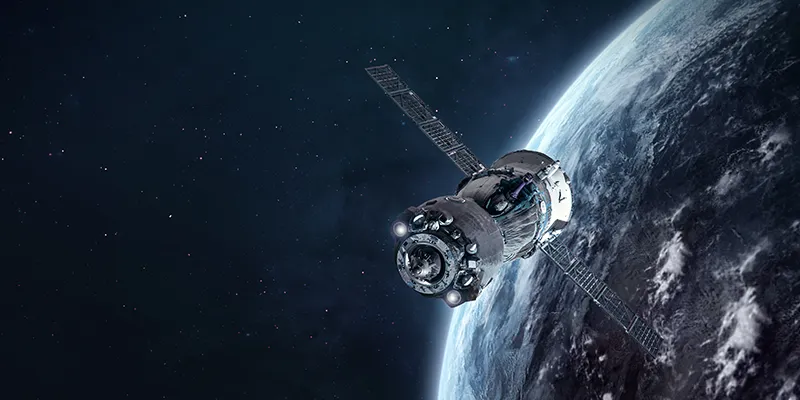Why India’s public and private spacetech players are betting on small satellites
Government agencies and spacetech startups are increasingly opting for the deployment of small satellite constellations, which can do the same job as conventional large-sized satellites but at a lower cost.
The race to win space began in 1957 when the Soviet Union launched Sputnik-1 into an elliptical low Earth orbit (LEO). Today, there are about 3,372 satellites in space, of which 2,612 are in LEO.
Like any machine, satellites have evolved since then. The last few decades have seen a boom in the development of small satellites (smallsats) along with large-sized geostationary satellites, which are time-taking innovations that need high investment. This is why small satellites have been attracting attention, from public and private players since 2012.

Image Credit: Shutterstock
Last September, during an industry event, NITI Aayog member and former Defence Research and Development Organisation (DRDO) chief V K Saraswat said small satellites would dominate the global space sector and revealed that 7,000 small satellites were expected to be launched by 2027, with a total value of $38 billion.
Small satellites draw stakeholder attention
Speaking to YourStory, Anirudh Sharma, Co-founder, and CEO of SID, IISc-incubated , explained that small satellites can do “the same job” as conventional satellites but at a “much lower cost”.
“Almost everything from our daily life such as GPS and communications depends on satellites. With technological advancements, smallsats have been replacing conventional large satellites, which are not only expensive but take two to three years development time. These reasons have led government and private players to move towards deploying smallsats,” Anirudh said.
While large satellites can weigh over 1,000 kg, he explained that small satellites are mainly classified as minisatellites, weighing between 100-500 kg; microsatellites, weighing between 10 and 100 kg, and nanosatellites, which weigh between 1 and 10 kg. There are also picosatellites that weigh less than 1 kg.
Awais Ahmed, Co-founder, and CEO of spacetech startup , explained that the shift towards small satellites is mainly because they take lesser time investment for development. He added that instead of launching one large satellite, a constellation of small satellites helped reduce the risk of mission failure.
“With small satellites, we can deploy a constellation of satellites instead of one large-sized satellite, ensuring wider coverage. It also means that even if a couple of satellites fail and stop working, we will still have other satellites in the constellation to complete the mission, which is not possible in case of one single large satellite,” he said.
He added that the smaller the satellite, the lesser is its launch cost.

Image Credit: Shutterstock
Applications of small satellites
Awais said small satellites could be used for enabling IoT networks, ensuring communication and internet reach, and for earth observation.
“Earth-observation satellites are broadly classified under two areas: radar imaging, which is deployed for weather surveillance; and optical imaging, which captures data for solving issues related to ground conditions. Pixxel operates in the optical imaging segment,” he says.
Bengaluru-based Pixxel is building the highest resolution hyperspectral satellite constellation that will provide 24-hour global coverage and high-quality remote sensing data. Such imageries can be used to identify problems related to agriculture, environment, natural disaster response, urban infrastructure, gas leak hazards among others.
Meanwhile, Bengaluru-based is developing a cluster of earth-observation nanosatellites, which will be programmed to stream near real-time high-resolution space videos.
Apart from this, small satellites can also be deployed for ensuring communication and internet connectivity. For instance, Elon Musk’s Space X has built Starlink, a constellation of small internet satellites in the LEO, to ensure internet access across the world. According to reports, as of now, there are 1,300 Starlink satellites in the LEO.
Sanjay Nekkanti, Founder and CEO of , says: “Small satellites enable rapid deployment of new technologies for a better understanding of the world around us. Using technology to augment traditional process and on-ground sensors in the fields of agriculture and weather would greatly help us maximise output and serve the needs of the country. This could also be supplemented with satellite-based IoT communication to provide improved business intelligence.”

Image Credit: Shutterstock
The market and outlook
All stakeholders unanimously agreed that the sector is expected to grow exponentially, especially with the opening up of the spacetech sector to include private players.
Ramesh Kumar V, Co-founder of Grahaa Space, feels the spacetech ecosystem might see around five to six unicorns in the next five years. He said the opening up of the space sector will mean not only spacetech startups but academia and students could also plan their own space missions and innovations.
Yashash Karanam, Co-founder of Aerospace, which is building in-space propulsion systems and orbital launch vehicles, said maybe hundreds of small satellites were being launched from India per year till now, but going forward after the opening up of the spacetech sector thousands of satellites may be launched every year.
“Launch vehicles and satellites are two different markets, but they are interdependent on each other. With the sudden boom in the small satellite sector, the demand for launch vehicles has also increased. But more satellites means more space traffic,” Yashash said.
According to data from MarketsandMarkets, the global small satellite market size is projected to grow to $7.1 billion by 2025 from $ 2.8 billion in 2020 at a CAGR of 20.5 percent. It revealed that the growing demand for LEO-based services, Earth observation imagery, analytics, and increasing number of space exploration missions are driving the growth of the small satellite market.
The increasing number of satellite deployment in space again has raised concerns regarding overcrowding and the formation of space debris — non-functional and malfunctioning satellites.
Digantara’s Anirudh said while the number of smallsats is increasing, there is a need to ensure space monitoring to keep track of space debris.
However, one thing is clear: the opening up of the sector will bring more players into the arena, helping India increase its contribution to the global space economy.
Edited by Teja Lele










